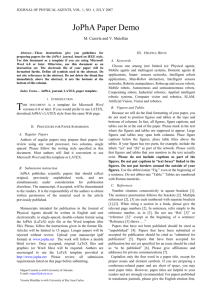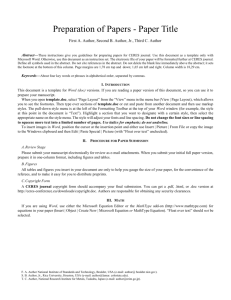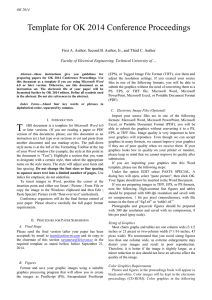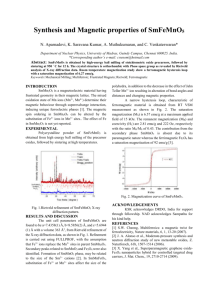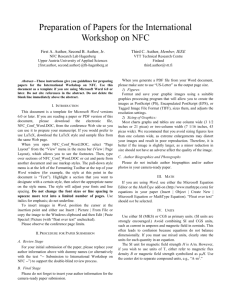Documentation Format - De La Salle University
advertisement
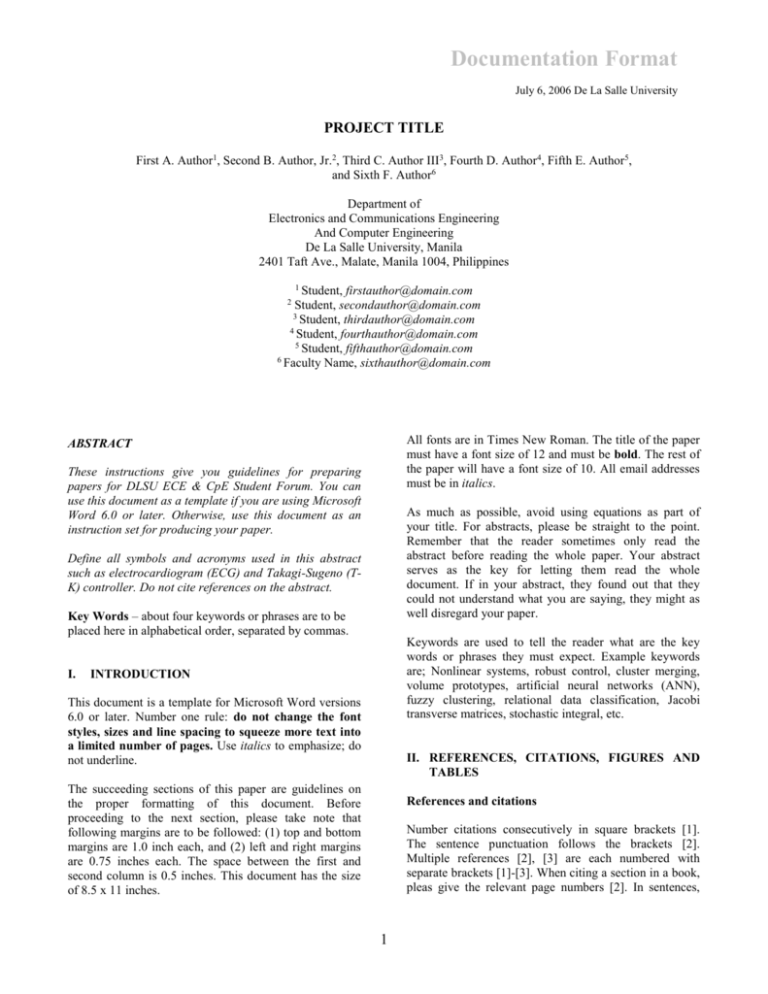
Documentation Format July 6, 2006 De La Salle University PROJECT TITLE First A. Author1, Second B. Author, Jr.2, Third C. Author III3, Fourth D. Author4, Fifth E. Author5, and Sixth F. Author6 Department of Electronics and Communications Engineering And Computer Engineering De La Salle University, Manila 2401 Taft Ave., Malate, Manila 1004, Philippines 1 Student, firstauthor@domain.com Student, secondauthor@domain.com 3 Student, thirdauthor@domain.com 4 Student, fourthauthor@domain.com 5 Student, fifthauthor@domain.com 6 Faculty Name, sixthauthor@domain.com 2 All fonts are in Times New Roman. The title of the paper must have a font size of 12 and must be bold. The rest of the paper will have a font size of 10. All email addresses must be in italics. ABSTRACT These instructions give you guidelines for preparing papers for DLSU ECE & CpE Student Forum. You can use this document as a template if you are using Microsoft Word 6.0 or later. Otherwise, use this document as an instruction set for producing your paper. As much as possible, avoid using equations as part of your title. For abstracts, please be straight to the point. Remember that the reader sometimes only read the abstract before reading the whole paper. Your abstract serves as the key for letting them read the whole document. If in your abstract, they found out that they could not understand what you are saying, they might as well disregard your paper. Define all symbols and acronyms used in this abstract such as electrocardiogram (ECG) and Takagi-Sugeno (TK) controller. Do not cite references on the abstract. Key Words – about four keywords or phrases are to be placed here in alphabetical order, separated by commas. I. Keywords are used to tell the reader what are the key words or phrases they must expect. Example keywords are; Nonlinear systems, robust control, cluster merging, volume prototypes, artificial neural networks (ANN), fuzzy clustering, relational data classification, Jacobi transverse matrices, stochastic integral, etc. INTRODUCTION This document is a template for Microsoft Word versions 6.0 or later. Number one rule: do not change the font styles, sizes and line spacing to squeeze more text into a limited number of pages. Use italics to emphasize; do not underline. II. REFERENCES, CITATIONS, FIGURES AND TABLES The succeeding sections of this paper are guidelines on the proper formatting of this document. Before proceeding to the next section, please take note that following margins are to be followed: (1) top and bottom margins are 1.0 inch each, and (2) left and right margins are 0.75 inches each. The space between the first and second column is 0.5 inches. This document has the size of 8.5 x 11 inches. References and citations Number citations consecutively in square brackets [1]. The sentence punctuation follows the brackets [2]. Multiple references [2], [3] are each numbered with separate brackets [1]-[3]. When citing a section in a book, pleas give the relevant page numbers [2]. In sentences, 1 Documentation Format July 6, 2006 De La Salle University refer simply to the reference number, as in [3]. DO not use “Ref. [3]” or “reference [3]” except at the beginning of a sentence: “Reference [3] shows … .” You can have as many references as you like as long as they are really needed. Refer to the References section for more details around the outside of your figures. Use the abbreviation “Fig.” even at the beginning of a sentence. Do not use color unless it is necessary for the proper interpretation of your figures. TABLE I UNITS FOR MAGNETIC PROPERTIES Symbol B Fig. 1. Magnetization as a function of applied field. Note that “Fig.” is abbreviated. There is a period after the figure number, followed by two spaces. It is good practice to explain the significance of the figure in the caption. on proper referencing. Please note that the references at the end of this document are in the preferred referencing style of the IEEE TRANSACTIONS. Give all author’s names: do not use “et. al.” unless there are seven authors or more. Use a space after author’s initials. Papers that have not been published should be cited as “unpublished” [4]. Papers that have been submitted for publication should be cited as “submitted for publication” [5]. Papers that have been accepted for publication, but not yet specified for an issue should be cited as “to be published” [6]. Please give affiliations and addresses for private communications [7]. Quantity H m magnetic flux magnetic flux density, magnetic induction magnetic field strength magnetic moment M magnetization 4M j J magnetization specific magnetization magnetic dipole moment magnetic polarization , susceptibility mass susceptibility permeability r w, W N, D relative permeability energy density demagnetizing factor Conversion from Gaussian and CGS EMU to SI a 1 Mx 108 Wb = 108 V·s 1 G 104 T = 104 Wb/m2 1 Oe 103/(4) A/m 1 erg/G = 1 emu 103 A·m2 = 103 J/T 1 erg/(G·cm3) = 1 emu/cm3 103 A/m 1 G 103/(4) A/m 1 erg/(G·g) = 1 emu/g 1 A·m2/kg 1 erg/G = 1 emu 4 1010 Wb·m 1 erg/(G·cm3) = 1 emu/cm3 4 104 T 1 4 1 cm3/g 4 103 m3/kg 1 4 107 H/m = 4 107 Wb/(A·m) r 1 erg/cm3 101 J/m3 1 1/(4) No vertical lines in table. Statements that serve as captions for the entire table do not need footnote letters. a Gaussian units are the same as cgs emu for magnetostatics; Mx = maxwell, G = gauss, Oe = oersted; Wb = weber, V = volt, s = second, T = tesla, m = meter, A = ampere, J = joule, kg = kilogram, H = henry. To be able to put a figure on top of a page, do the following steps: (1) save your image as a .jpg or .gif file, (2) then in Microsoft Word, select the “Insert Text Box” for the “Drawing” toolbar, and click the leftmost part of the first line of the page, (3) after inserting the textbox, click “Insert | Picture | From File” to insert the picture (4) arrange the text box so that the whole image is resized to be somewhat equal to the with of this column, as shown in Fig. 2. Capitalize only the first word in a paper title, except for proper nouns and element symbols. If you are short of space, you may omit paper titles. However, paper titles are helpful to your readers and are strongly recommended. For papers published in translation journals, please give the English citation first, followed by the original foreign-language citation [8]. If the resizing the text box would make the image unreadable, you can resize it to have a width of two columns, as shown in Fig. 3. Figures After resizing the whole image, right click the text box and select “Format Text Box.” Remove all borders and shading and the “Colors and Lines” Tab. For the “Layout” tab, choose “Square.” All figures must be placed at the top of a page, as shown in Fig. 1. Every figure must have a corresponding caption placed under it. The caption must be left justified and should have a font size of 8. Please do not include captions as part of the figures. Do not put borders 2 Documentation Format July 6, 2006 De La Salle University NC Tables S N C Tables must also be placed at the top of a page, as shown in Table I. If a figure exists in the same page where the table is to be placed, the table must be placed under the figure. N u i 1 j 1 2 ij ci X j N min ci c j 2 (2) 2 A technique in inserting an equation to this document of to create first a 2 by 1 table. The equation is placed in cell 1, and the equation number is placed in cell 2, which is enclosed in (parentheses). Table captions must be placed at the top of each table with the format shown in note that the caption above each table must be formatted to have THIS KIND OF STYLE. Sometimes, is also possible to have a citation inside the Fig. 2. The control system of the module. table. You can also provide a sub-caption to every entry inside the table. Do not abbreviate “Table.” Tables are numbered with Roman numerals. Be sure that the symbols in your equations have been defined before the equation appears or immediately following. Italicize symbols (T might refer to temperature, but T is the unit tesla). Refer to “(1),” not “Eq. (1),” nor “equation (1),” except at the beginning of a sentence: “Equation (1) is … .” III. MATH If you are using Microsoft Word, use the Microsoft Equation Editor, Visio, or the MathType add-on (http://www.mathtype.com) for equations in your paper. “Float over text” should not be selected, see (1). Another example of an equation is depicted in (2). If an equation is to be used or cited more than once in this document, an equation number must be placed, as depicted in equations (1) and (2). Else, an equation number is not needed. ri n 1/ n ij i 1/ n IV. HELPFUL HINTS Figures and Tables Figure axis labels are often a source of confusion. Use words rather than symbols. As an example, write the quantity “Magnetization,” or “Magnetization M,” not just “M.” Put units in parentheses. Do not label axes only with units. As in Fig. 1, for example, write “Magnetization (A/m),” not just “A/m.” Do not label axes with a ration of (1) j 1 1 It is recommended that footnotes be voided (except for the unnumbered footnote with the receipt date on the first page). Instead, try to integrate the footnote information into the text. 3 Documentation Format July 6, 2006 De La Salle University quantities and units. For example, write “Temperature (K),” not “Temperature/K.” example, write “do not” instead of “don’t.” The serial comma is preferred: “A, B, and C” instead of “A, B and C.” Multipliers can be especially confusing. Write “Magnetization (kA/m)” or “Magnetization (103 A/m).” Do not write “Magnetization (A/m) x 1000” because the reader would not know whether the top axis label in Fig. 1 meant 16000 A/m or 0.016 A/m. Figure labels should be legible, approximately 8 to 12 point type. IV. CONCLUSION The conclusion in any paper must contain the review of the main points. Do not replicate the abstract as the conclusion, which is a common mistake to first-time authors. A conclusion might elaborate on the importance of the work or suggest applications and future directives. Footnotes Number footnotes separately in superscripts.1 Place the actual footnote at the bottom of the column in which it is cited do not put footnotes in the reference list (endnotes). Use letter for table footnotes (see Table I). REFERENCES [1] Abbreviations and Acronyms [2] Define abbreviations and acronyms the first time they are used in the text, even after they already been defined in the abstract. Abbreviations such as IECEP, IEEE, SI, ac, and dc do not have to be defined. Abbreviations that incorporate periods should not have spaces: write “C.N.R.S.,” not “C. N. R. S.” Do not use abbreviations in the title unless they are unavoidable. [3] [4] [5] [6] [7] Other recommendations [8] Use one space after periods and colons. Hyphenate complex modifiers, “zero-field-cooled magnetization.” Avoid dangling participles, such as, “Using (1), the potential was calculated.” [It is not clear who or what used (1).] Write instead, “The potential was calculated by using (1),” or “Using (1), we calculated the potential.” [9] [10] [11] Use a zero before decimal points: “0.25,” not “.25.” Use “cm3,” not “cc.” Indicate sample dimensions as “0.1 cm x 0.2 cm,” not “0.1 x 0.2 cm.” The abbreviation for “seconds” is “s,” not “sec.” Do not mix complete spellings and abbreviations of units: use “Wb/m2” or “webers per square meter,” not “Wb/square meter.” When expressing a range of values, write “7 to 9” or “7-9,” not “7~9”. [12] [13] F. A. Author, S. B. Author, and T. C. Author, “The complete title with only the first letter of the first word in capital letter,” Originating Transaction or Journal, vol. 1, pp. 1522-1533, Sep. 1992. W.-K. Chen, Linear Networks and Systems (Book style). Belmont, CA: Wadsworth, 1993, pp. 15-64. H. Poor, An Introduction to Signal Detection and Estimation. New York: Springer-Verlag, 1985, ch. 4. B. Smith, “An approach to graphs of linear forms (Unpublished work style),” unpublished. E. H. Miller, “A note on reflector arrays (Periodical style— Accepted for publication),” IEEE Trans. Antennas Propagat.,to be published. J. Wang, “Fundamentals of erbium-doped fiber amplifiers arrays (Periodical style—Submitted for publication),” IEEE J. Quantum Electron., submitted for publication. C. J. Kaufman, Rocky Mountain Research Lab., Boulder, CO, private communication, May 1995. Y. Yorozu, M. Hirano, K. Oka, and Y. Tagawa, “Electron spectroscopy studies on magneto-optical media and plastic substrate interfaces (Translation Journals style),” IEEE Trans. J. Magn.Jpn., vol. 2, Aug. 1987, pp. 740-741 [Dig. 9th Annu. Conf. MagneticsJapan, 1982, p. 301]. (Basic Book/Monograph Online Sources) J. K. Author. (year, month, day). Title (edition) [Type of medium]. Volume(issue). Available: http://www.(URL) J. Jones. (1991, May 10). Networks (2nd ed.) [Online]. Available: http://www.atm.com. (Journal Online Sources style) K. Author. (year, month). Title. Journal [Type of medium]. Volume(issue), paging if given. Available: http://www.(URL) R. J. Vidmar. (1992, August). On the use of atmospheric plasmas as electromagnetic reflectors. IEEE Trans. Plasma Sci. [Online]. 21(3). pp. 876-880. Available: http://www.halcyon.com/pub/journals/21ps03-vidmar Motorola Semiconductor Data Manual, Motorola Semiconductor Products Inc., Phoenix, AZ, 1989. F. A. Author was born in Makati, Philippines in 1982. He is currently working toward his B. S. degree in Electronics and Communications Engineering at De La Salle University, Manila. He is currently an member of the Electronics and Communications Engineering Society (ECES) and the Institute of Electronics and Communications Engineers of the Philippines (IECEP). His research interests include pattern recognition and digital watermarking. A parenthetical statement at the end of a sentence is punctuated outside of the closing parenthesis (like this). (A parenthetical sentence is punctuated within the parenthesis.) In American English, periods and commas are within quotation marks, like “this period.” Other punctuation is “outside”! Avoid contractions; for 4 Documentation Format July 6, 2006 De La Salle University S. B. Author etc. T. C. Author etc. F. D. Author etc. F. E. Author etc. S. F. Author (S’78-MEng'88) was born in Marikina, Philippines in 1955. He is currently a Professor in the Department of Electronics and Communications Engineering at De La Salle University Manila, Philippines. His main research interests are in the areas of robust clustering methods and pattern recognition. 5
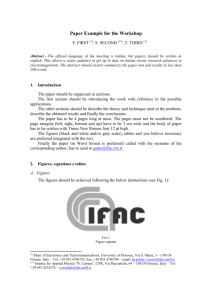
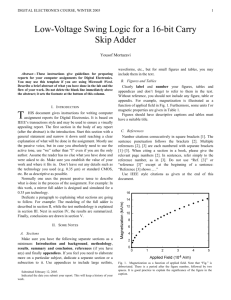
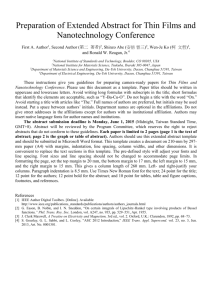
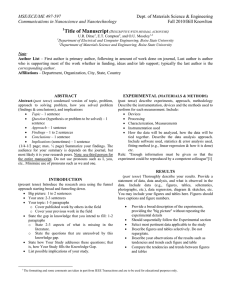
![Photoinduced Magnetization in RbCo[Fe(CN)6]](http://s3.studylib.net/store/data/005886955_1-3379688f2eabadadc881fdb997e719b1-300x300.png)
